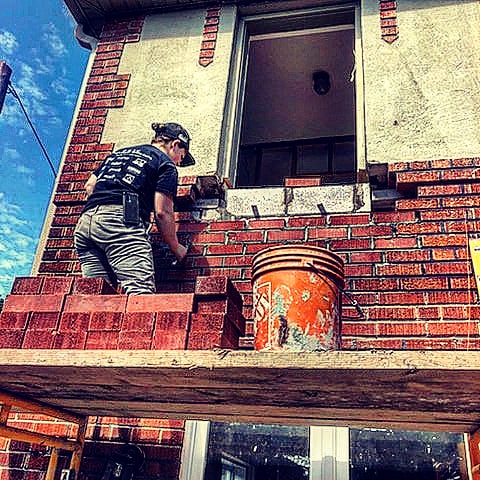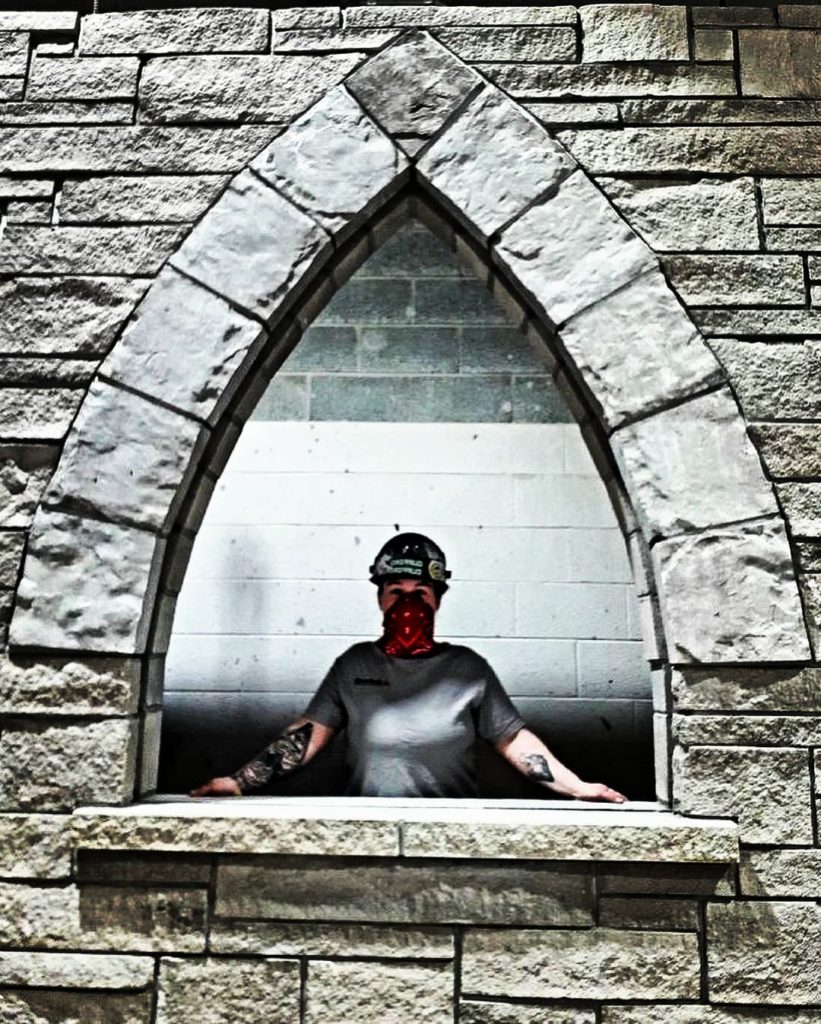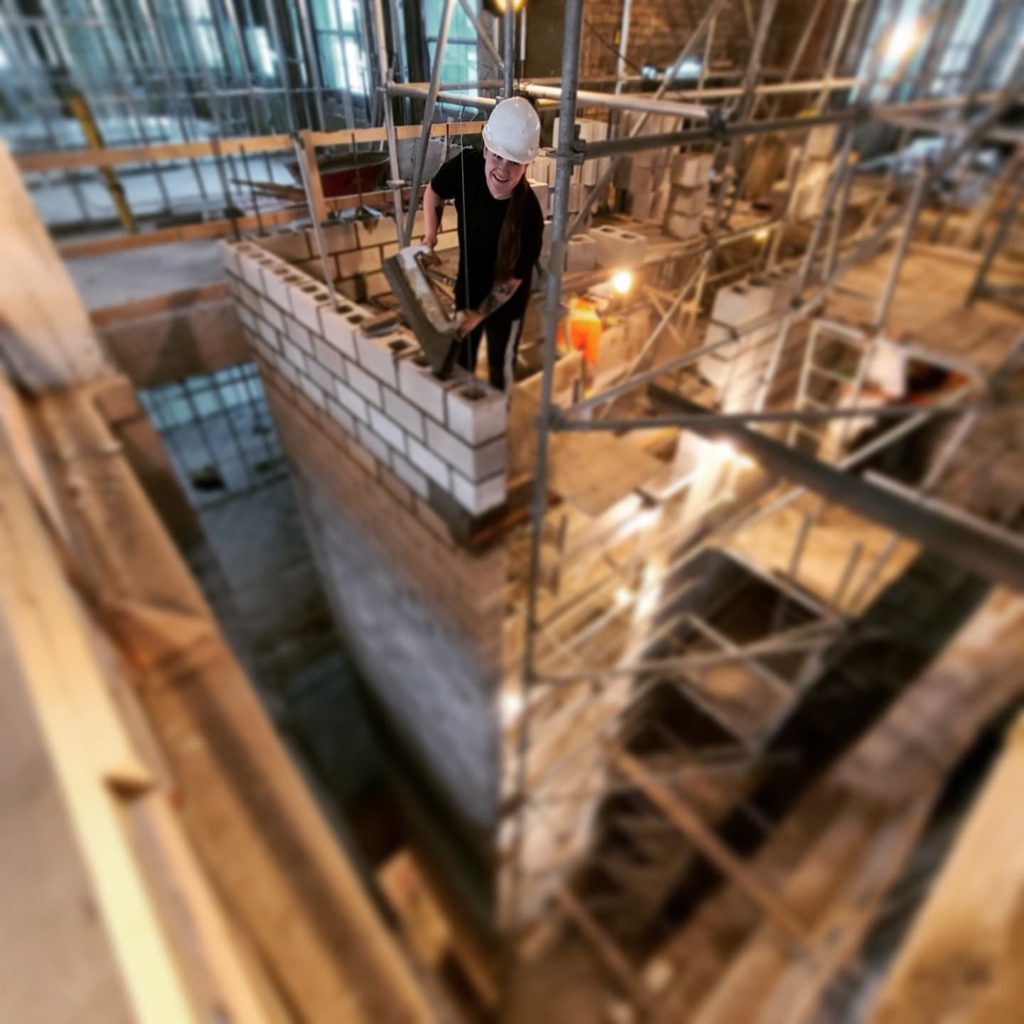Sponsored By:
Words: MASONRY
Photos: Julia Rose
Editor’s Note: This month we sat down with Julia Rose of Clifford Masonry. Julia is following in her grandfather’s footsteps and is continuing his legacy within the industry. She is proud of what she has accomplished thus far and is looking forward to what the future holds for her. We’d like to thank Julia for taking the time to talk with us and Masonry Cosmetics for sponsoring this important series.
MASONRY Magazine: Tell us about yourself.
Julia Rose: I’m Julia Rose and I’m 26 years old. I’m a bricklayer working out of Toronto, Ontario, Canada, originally from a small town close by. I work for a large restoration company in the city called Clifford Restoration. We’ve been in business for 51 years. I’m a bricklayer and their lead hand on my current site. Usually, site to site, I end up being the lead hand with my current foreman. I take on roles around the job for block, brick, stone, or anything that needs to be done. I’ll leave the crew and do so—and try to get my little skill set brought to the table there.
M.M.: Did you have an apprenticeship or anything like that before starting with Clifford Masonry?
J.R.: Yeah, I’ve nearly completed my apprenticeship. I’ve done the required 5,600 hours here in Canada to complete the brick and stone masonry course. I’ll be writing my Red Seal Exam within the next six months and then I’ll be an official Red Seal Mason. I’m going back for my level three, assessment of forcing in January. Then, I’ll be there for two months in school. It’s the advanced level, so we’re doing fireplaces in natural stone. Then that’s it; write my test, and I’ll be done.
M.M.: How did you get started in the industry?
J.R.: So, I had no construction industry experience whatsoever. I was a personal trainer and really into fitness. Before that, I was kind of living a life nobody would be proud of and I needed something to set me on the right path. So, I found this course online for free masonry training at the Ontario Masonry Training Center. I immediately signed up, and they got me set up. We did five months, and I learned how to lay brick and block. The ladies gave me my tools and they got me set up with my current employers. I’ve been with Clifford ever since.
M.M.: So you went from physical training and fitness to masonry?
J.R.: I had the fitness aspect of being in this industry. Even so, it was still a huge learning curve for my body to adapt to lifting 70-pound bags of mortar over my shoulder. It’s something that nothing could ever train you to do until you get on the job site and you start just hauling and going crazy. So, you know, the first year was hard, but I’ve adapted over time.
M.M.: Do you have any family members that are in the industry?
J.R.: My great-grandfather was a stonemason in Guelph, Ontario. He had his own little construction company, and my granddad was his laborer. So, they worked together and I had no idea that they were into bricklaying when I started, but now it’s a point of pride for me to carry on the family tradition as a female. I love the fact that I get to do that. I hope that he is looking down on me (my great-grandfather) and going, “Wow, she’s kicking ass!”

M.M.: Tell me about some of the masonry classes that you’ve taken.
J.R.: I will be doing my third level. There are three levels that we have in Canada. You go for two months for the first level to get your red seal, so a beginner course, which is a very simple block. It included how to read a tape measure, how to make mortar, and stuff like that. Then, the training becomes intermediate as you get into arches. At this point, you should be a little bit more skilled; you need to pass an assessment and lay a simple block and brick wall.
Then, it becomes more advanced if you go into the fireplaces and natural stone. So we’ve progressed every year and should be able to come back and do more advanced things. If you can’t, you need to go back out into the world, gain more experience, and then try again. So far, I’ve been successful; I haven’t had to come behind me, I just went right into the class.
M.M.: Where do you see yourself in five to ten years?
J.R.: I would say that I would like to be leading my large guild jobs. As a woman working around Toronto with my current employer, I don’t see myself leaving that company. But I do want to progress into more of a supervisor role. I am still on the tools, but I love that I could be running a job from start to finish. Some of these buildings that we work on are pretty spectacular, so it’d be awesome to have my name on them.
M.M.: What’s going to keep you interested in the masonry industry moving forward?
J.R.: I’m obsessed with keeping the famous structures alive around the city and seeing the work I’ve done throughout the next generations. I can bring my kids around the city and show them, “Hey, Mom was on that” and, “Mom did that.” That’s what will keep me interested in getting more women involved in the trades, making sure to inspire others to see the beauty in masonry as a whole—also creating something that will last the test of time. Masonry is one of the oldest trades, the structures that we build can and do last for hundreds of years. So that’s the thing that inspires me the most to keep going.
M.M.: How is it working with the older guys in the industry?
J.R.: At first, it was difficult. It’s hard for people to adapt to the sight of me on site. I’m not a big person; I’m a pretty small woman, and suddenly, they see me slinging blocks around the site and are almost taken back. I have to make it known that I am capable of doing what they do. They don’t just look at me and go, “Oh, yeah, like, she’s going to be great.”
They have zero expectations of me. Then, all of a sudden, they’re blown away. People have been a little bit rude to me in the past, but I’ve gained this knowledge and experience that I don’t need to prove myself to them anymore. I can do the work; that is enough for me.
M.M.: What challenges have you faced so far, being a female in the industry, aside from being young?
J.R.: I guess it would be the physical challenges or gaining the muscle and stamina to keep up with the men. That was challenging. The height difference? I’m 5’2″ and some of these guys that I work with are around 6’5″. So when I’m laying blocks on the line with them on the other side, I need to continue to lay blocks with them. I can’t say, “Hey, can we raise the scaffold?” No, I have to stand on two or three blocks to get it done. And sometimes I do.
The other thing is just being taken seriously as a woman. It’s been challenging; I want that respect immediately, but sometimes those are things that need to be earned and that’s fair. Masonry is an industry that women are pretty new to, so I can’t expect the world to change overnight. Just because I think it should, doesn’t mean everybody else agrees. I’m also sore all the time.

M.M.: What does your daily routine look like?
J.R.: My routine is to get up at about five o’clock, have some breakfast with myself for the day, and coffee. I bike to work because I don’t drive – the city’s crazy. When I get there, they start organizing the crew for what we’re going to do that day. Recently, it’s been building elevator shafts and I get right to work. I am the health and safety personnel on-site, so I do all the paperwork for the day regarding health and safety.
Then, I instruct the guys what they need to prepare for me when I show up: start laying blocks, make the mortar, get my cuts ready, and more stuff like that. Hop on the scaffold and slam. In the day-to-day, that’s pretty boring for me right now. But, some days are more exciting than others: reading blueprints, figuring out what jobs need to be done around the site, and keeping everything organized. It’s kind of my role as a lead hand on that site.
M.M.: Tell me a bit about some of the projects that you’ve been involved in.
J.R.: I’ve done some pretty cool projects from the City of Toronto and my apprenticeship. Probably, the most notable would be from there. I know that in the states there is the Hyatt brand of hotels. I don’t know if you’re familiar with those, but there’s a famous branch in the city called the Park Hyatt. It’s a beautiful, old hotel that I spent my entire three years at from start to finish. It was completely ripped apart, gutted to the bare bones, and built back into this beautiful masterpiece, which I could never afford to stay in.
I am very proud of the work that we did there. There was lots of beautiful stonework, brickwork, and thousands and thousands of blocks, which I got to do all of the layouts for. I was excited to be a part of something so famous. Now I’m working at the university, which is also very cool for me. The campus is huge in Toronto, and I can walk past that one day and say, “Hey, that was me.” I’ll say that those are my two most notable projects so far.
M.M.: What advice would you give to someone interested in getting into the masonry industry?
J.R.: I would say listen to the people around you who are trying to help because they have been through the same experience. Many new guys come in, and they have that ego like, “I’m the best bricklayer. I don’t need your advice. I don’t need your help.” They’ve been doing it for longer than you’ve been alive. Just listen and take the time to go to school and do it right.
It’s not like it was thirty years ago when you could just become a bricklayer. You have to take the steps, you have to complete the programs, and you need to get that red seal or you’re going to be stuck in this apprentice laborer position forever. I don’t want to see that happen to people.
M.M.: Was there anything else that you wanted to add?
J.R.: Women out there, don’t think that you can’t do this just because you are a girl. It is 100% possible. Trust me; I’ve had a crazy life up to this point and I never saw myself being in anything like this. But, in three years, I’ve almost completed a red seal trade and I’ve doubled my salary. The opportunities that you can have with this are incredible.
It’s so hard to get by on minimum wage in this economy right now. You don’t need to get student loan debts to be successful in life. Take on a trade; it doesn’t need to be masonry, but anything you’re interested in. There are so many options out there, so take a chance on it and don’t think that it’s just for the guys.
